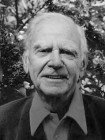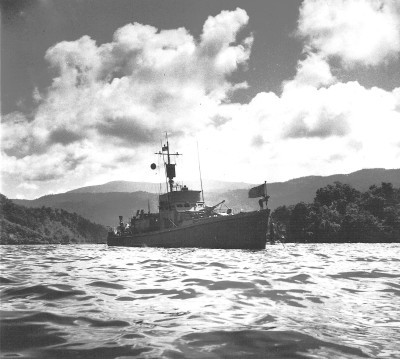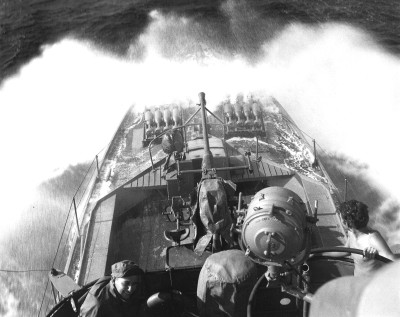![]()
 Ted Treadwell 1916 - 2011
Ted Treadwell 1916 - 2011
Theodore Rogers Treadwell Jr., age 95, passed away peacefully in his home November 3, 2011, surrounded by his family. He was a resident of The Willows Retirement Home in Bellingham, Washington, having moved there in 2007.
Welcome to Splinter Fleet, a web site devoted exclusively to the wooden SC Subchaser, the smallest commissioned warship of the U. S. Navy during World Wars I and II.
Over 40,000 men served on subchasers in World War II, and in those days the word “Subchaser” was as familiar to the folks at home as the words “PT Boat,” “Tin Can Destroyer,” “Liberty Ship” and “Jeep Carrier.” Today only the people who lived during that time remember that subchasers existed and even many of these have forgotten about them. That’s because subchasers didn’t have the glamour of PT boats, the power and speed of destroyers, or the silent mystery of the submarines. Consequently they weren’t romanticized by the media and kept in the public eye.
Subchasers (also called “submarine chasers”) were built and launched in great haste at the outset of World War II because German U boats were roaming the Atlantic at will, unopposed, sinking merchant vessels with complete abandon with no regard for neutrality. They were doing this at an alarming rate. Tens of thousands of tons of valuable cargo were being sunk almost daily, some within sight of our shores. The Germans were so bold and aggressive their U boats even landed counteragents on beaches in Maine and in Florida. In the summer of 1942 U boats sank more ships and took more lives than were lost at Pearl Harbor. Most American citizens were unaware of the seriousness of our situation, but the navy knew, and the U boat menace became our navy’s #1 priority even at the cost of delaying our response to the Japanese aggression in the Pacific.
The U.S. navy had been virtually destroyed at Pearl Harbor. On the entire east coast we had only one bona fide antisubmarine vessel. Something had to be done quickly to stop the U boats. The big shipyards were backed up with contracts for building carriers, cruisers and destroyers and steel was allocated for these as well as tanks, guns and many other military devices.

SC 648 at Hollandia New Guinea 1944.
Subchasers could be built of wood in small boatyards on both coasts and the Great Lakes and Gulf regions. They could be built fairly quickly (60 to 120 days depending on availability of materials and components) by craftsmen who knew how to build wooden boats. Many of the boatyards were small, family-owned businesses, only a few of which exist today. The navy wasted no time letting out contracts to fifty such boat yards. By the time the war ended 438 wooden SC subchasers had been launched and commissioned.
At this stage of the war subchasers and aircraft patrols were the only means of defense against the U boats. But though they were sturdy and very seaworthy little vessels everyone knew from the beginning they were inadequate, both in size and armament, to effectively destroy the U boat scourge. When surfaced, a German submarine could go faster, and its 4" guns had much longer range than the 3" 50 or 40mm guns on the subchaser, so all the U boat had to do was get out of range and sink the subchaser with its cannon on its own terms. But the subchasers were a real nuisance to the U boats because the U boat was only effective (except at night when working in wolf packs) when it was below the surface at periscope depth sighting and aiming at an enemy ship at which to fire its torpedoes. So respectful were U boats of the potency of the subchaser one U boat commander circulated the following advice to fellow U boats:
‘The small subchasers are dangerous because of their silhouettes, which often don’t show up in the periscope. On the surface they can be detected by their wake but not by their shadow. If they would ever learn to patrol at slow speed, they would be fatal.’
Once a subchaser detected the presence of a U boat with its sonar equipment it had a big advantage. The subchaser could attack with depth charges. It could force the U boat to stay submerged and thus drain its batteries (for oxygen supply). In this situation the U boat would be unable to attack, thus rendering it powerless and allowing ships of a convoy to proceed unharmed.
When larger ships such as destroyers and destroyer-escorts became available the subchasers continued to escort and screen for submarines but they were no longer our first line of defense. The destroyers and DEs combined with naval airplanes to form killer groups that could search and destroy the U boats very effectively. It was in this way that the U boat threat was eliminated and the Battle of the Atlantic was won. Throughout the war nevertheless, the little subchasers provided antisubmarine escort for innumerable convoys of ships and continued to patrol harbor entrances while screening for enemy submarines.
When not engaged in escorting convoys or patrolling harbors the subchasers were used in a variety of ways in all theaters of the war. They were ideally suited for landing control work in hundreds of amphibious landings in the Mediterranean and the Pacific. Quiet in operation, maneuverable, and with their shallow draft, the SCs could get in close to the beaches and guide the waves of landing boats assaulting the beachhead, after which they served as a communication center for beachmasters and landing control officers. In the days following the landing they would patrol the area, lay smoke screens, rescue downed pilots, ferry personnel and perform other necessary duties. Some subchasers were equipped for shallow water mine sweeping and were called upon several times to perform this highly dangerous work prior to D-day.
Eight subchasers were converted to PGM gunboats and used to advantage in the liberation of the Philippines. Four gunboats were sent up the Mindanao River to Fort Pikit, which they captured. It was the first time since the Civil War that commissioned naval vessels operated behind enemy lines.
In the entire war only one subchaser received official credit for sinking an enemy submarine, despite numerous depth charge attacks made by SCs throughout the war against underwater objects. On 12 July 1943 SC 669 sank Japanese submarine RO 107 off Kolombangara Island in the central Solomons.

SC 648 plows into heavy seas.
Sometimes when I ask people if they know what a subchaser was they’ll hesitate, then ask, “Wasn’t it something like a PT boat?” The answer of course, is an emphatic “No!” SCs were 110' long while PT boats were only 80' long. Subchasers were not high speed vessels as their name implies. Their normal cruising speed was 12 knots and their flank speed seldom could get up to 20 knots, whereas a PT boat could do 40 knots or better. SCs were designed to search and destroy underwater submarines while PT boats were designed for high speed surface warfare. Finally, as stated earlier, SCs were individually commissioned warships of the navy. PT boats were not commissioned individually but collectively in squadrons.
The normal complement on a subchaser was 3 officers and 24 enlisted men. The officers and enlisted men who served aboard SCs were mostly reservists, unaccustomed to the rigid ways of the navy and lacking the finer points of ship discipline and formality. Many of the officers were recent college graduates, with only 90 days of basic training and an additional 60 days of specialized training at SCTC (Subchaser Training Center, Miami.) The “Ninety-day Wonders” and their free-wheeling, often scruffy-looking crews ignored many of the ways of the regulation navy and settled for their own set of rules. They were sometimes called the “Donald Duck Navy” but most subchaser men didn’t mind. They were a proud lot and many an ex-subchaser sailor who saw service on other ships says he is most proud of his subchaser days.
At sea the subchasers were rough-riding bucking broncos. Their narrow beam and shallow draft produced a constant roll - even in protected waters - which could cause queasiness for many experienced sailors. In heavy seas the tendency to roll combined with a violent pitching motion, causing the ship to corkscrew, precluding any chance for real rest or sleeping. Seasickness was common among subchaser sailors, particularly on the first day out after being in port several days.
Note: for information on how to locate shipmates, service records, diaries or logbooks, use the links on the Subchaser Information Sources page. Thank you.
This website was launched in November 1999 by Ted Treadwell Jr. who served on U.S.S. SC 648 for two years in the Southwest Pacific during World War II (the last nine months of that service as her commanding officer), and authored two books about the 110' SC wooden subchasers of WWII.
